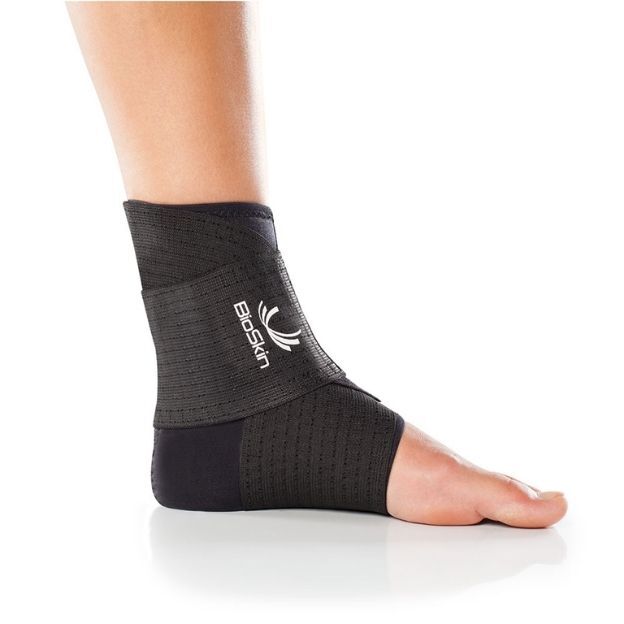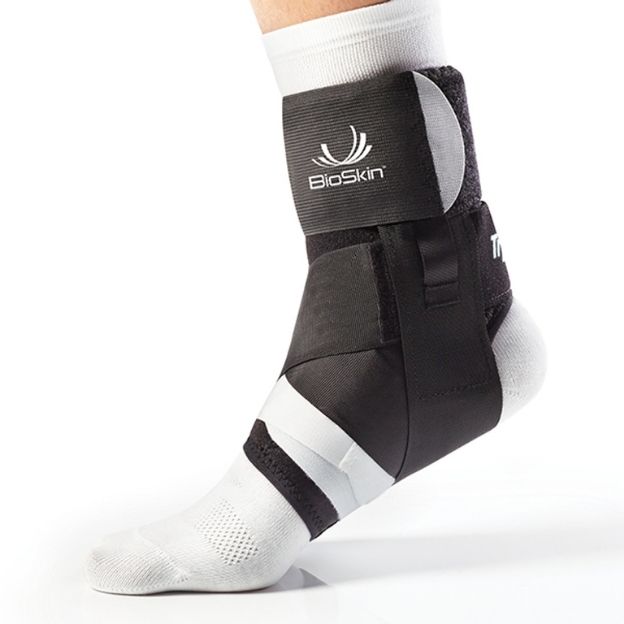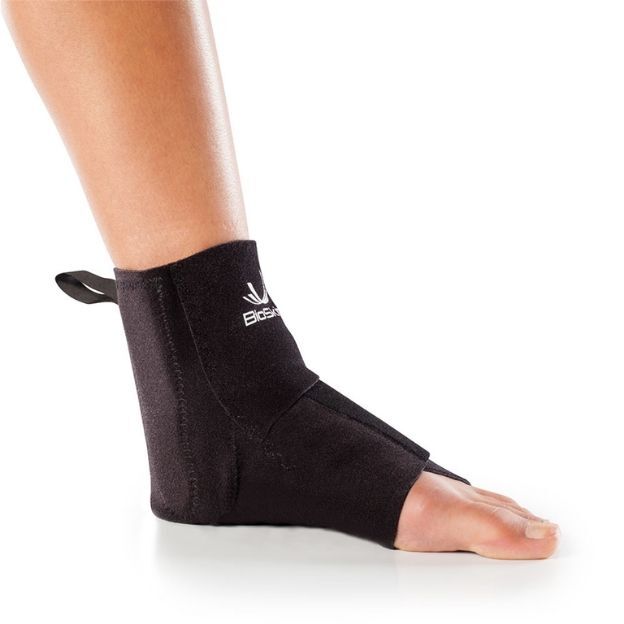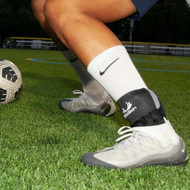Compression limits fluid buildup, eases soreness, and helps you walk with more confidence sooner. A compression ankle brace is part of that picture, not the whole cure. We pair it with load management, short, frequent walks as tolerated, and a steady progression of balance and strength work.
Clinical guidance backs this approach: early care for ankle sprains typically combines functional support you can wear in shoes with consistent compression to manage swelling while you stay moving safely.
What Compression Does and What It Doesn’t
Compression applies gentle, even pressure around the ankle joint to limit excess fluid in the tissues. That helps reduce swelling, ease soreness, and make walking feel steadier while ligaments and soft tissue work through the healing process.
With medical-grade compression, the fabric also supports nearby muscles and tendons, so movements feel more controlled during daily activity or physical therapy.
Too little pressure won’t do much; too much can irritate skin or slow circulation. Aim for snug, not tight: you shouldn’t feel numbness, tingling, or cold toes, and socks should slide on without leaving deep marks. Recheck fit as swelling changes and adjust wear time if the area gets irritated.
Compression is support, not a cure. It won’t repair a torn ligament or fix a significant ankle injury on its own, and it isn’t a substitute for loading progressions, balance work, or clinician guidance. Used properly (via a sleeve or brace that fits well), it helps relieve pain, control swelling, and protect the ankle while you follow a complete recovery plan.
Compression vs. Structure: Finding Your Level
Start by matching support to symptoms. Pick the lightest option that controls swelling and pain.
Sleeves and wraps (compression-first)
Choose an ankle sleeve or wrap for mild swelling and day-to-day ankle support. These provide steady compression to reduce puffiness and ease ankle pain without changing how your shoes fit.
They’re a good fit for a recent sprained ankle that feels mostly stable, desk-to-steps days, and light training where you want comfort and mobility more than rigid control.
Strap designs (compression and targeted control)
If you roll your ankle often or feel sloppy on uneven ground, a strap brace adds directional stability on top of compression. Figure-8 or stirrup straps limit the lateral and medial rolling of the hind foot that aggravates tissues, offering targeted support while you keep moving. This middle tier suits lingering instability, return-to-run plans, and active jobs with enough structure to guide motion, but still flexible for rehab drills.
Semi-rigid options (maximum control)
After a bigger injury or when confidence is low, semi-rigid designs add stability with shells or reinforced stays. They hold a safer range while swelling settles and strength returns, making them useful for early phases after significant sprains or when a healthcare provider wants tighter movement limits. As strength improves, many people step down to straps, then to sleeves.
Consistent bracing during higher-risk activity can lower re-sprain rates. The best choice is the one you’ll wear.
Fitting Rules
Getting the right fit matters as much as picking the right brace. A compression brace should feel snug and maintain even pressure across the foot, heel, and ankle. Follow the size chart carefully by measuring at the narrowest part of your ankle for a perfect fit that supports circulation and comfort.
Check blood flow by pressing a toenail until it blanches; color should return within a few seconds. If it doesn’t, loosen or readjust. Avoid over-tightening straps or wearing a brace that’s too small; it can restrict movement and reduce circulation instead of helping it.
As swelling goes down, reassess your fit. A brace that once felt secure may start slipping, and staying in one size too long can cause rubbing or irritation. A proper fit allows consistent compression, promotes healing, and prevents further injury, especially if you’re managing Achilles tendonitis, plantar fasciitis, or general ankle inflammation.
Comfort and adherence go hand in hand. The brace that feels good is the one you’ll actually wear, giving your ankle the support it needs for steady recovery and long-term mobility.
Bioskin Picks for Compression-First Support
Choose the option that matches your day, then adjust as swelling changes.
Ankle Compression Sleeve + Wrap

Daily swelling control with smooth, consistent compression; add the figure-8 wrap on busier days for extra stabilization without bulk. Breathable, washable fabric (air dry) keeps all-day comfort in shoes.
TriLok™ Ankle Brace

Compression plus targeted strap support for recurring sprains or uneven ground. The real magic of this brace is the FootLok strap. This provides superior medial or lateral support, along with treatment for conditions such as plantar fasciitis and peroneal tendonitis.
AFTR™ DC

Compression with an easy front-opening design for significant swelling or post-procedure wear. Dial in pressure evenly around the ankle and adjust throughout the day as edema shifts.
Setup and First Week Plan
A smooth start helps your brace work the way it should. Follow these steps for the best results during your first week of wear.
1. Fit first.
Measure according to the size chart and confirm a snug, not tight, fit. Your brace should apply even compression around the ankle and Achilles tendon area without limiting blood flow or leaving red marks.
2. Break in gradually.
Wear the brace for one to two hours at a time during the first couple of days, then increase as comfort improves. Check the skin for irritation or pressure points, especially near the heel or where straps overlap.
3. Layer smart.
Use a thin, moisture-wicking sock under the brace if needed; it can prevent rubbing and wick away sweat during long wear periods. Always air dry the brace after use to preserve the fabric and maintain consistent compression.
4. Adjust as swelling changes.
If your ankle feels looser after a few days, re-tighten the straps slightly or move to a lighter sleeve. When swelling decreases significantly, switching to a lower-profile model helps maintain comfort and allows for greater motion during rehab or daily activity.
5. Pair with rest and movement.
Combine brace wear with short walking intervals, gentle stretching, and rest as guided by your clinician. Proper compression can help reduce inflammation, promote healing, and provide support for weak ankles recovering from repetitive stress or minor injury.
Common Mistakes to Avoid
A compression ankle brace can make recovery smoother, but only if used correctly. These are the missteps that slow progress or cause discomfort:
1. Over-tightening the brace.
More tension doesn’t mean more stability. Straps that are too tight can block circulation or cause numbness. Aim for firm, even pressure that is not restrictive.
2. Ignoring changes in fit.
As swelling decreases, compression loosens. Recheck your sizing after the first week and adjust or switch models for the perfect fit. Staying in an oversized or stretched sleeve won’t provide consistent pressure or support.
3. Relying on compression alone.
A brace helps manage swelling and provide pain relief, but strength and balance work are what restore long-term stability. Combine use with guided treatment, short walks, and clinician-approved loading to keep the ankle joint strong.
4. Using worn or low-quality gear.
Frayed straps and worn-out elastic lose their ability to provide compression and extra support. Choose good quality, medical-grade materials that maintain shape through wear and washing.
5. Returning to sport too soon.
Even if pain fades, tissues still need time to adapt. Pushing back into cutting or pivoting movements too early increases your risk of re-injury.
6. Missing warning signs.
If you can’t bear weight, notice deformity, or have severe pain that doesn’t improve, contact a healthcare provider right away. Proper bracing helps manage symptoms, but ongoing issues may signal a more serious ankle injury that needs medical review.
Make Compression Work for You
Compression can turn recovery into steady progress instead of daily discomfort. Measure your ankle, find the level of support that matches your activity, and choose a brace that fits comfortably in your routine.
Frequently Asked Questions
What level of ankle support do I need after a sprain?
Start with light compression for daily swelling control, then step up to strap support if the joint feels unstable on stairs or uneven ground. If confidence is still low, a semi-rigid design adds more control for short periods while you rebuild strength.
Does compression actually relieve pain, or just swelling?
Both. Proper, even pressure limits fluid buildup and can calm irritated tissues, which helps relieve pain. It won’t fix a torn ligament by itself, but it makes walking and rehab work more comfortable as you recover.
When is an ankle sleeve the right choice, and when isn’t it?
Use an ankle sleeve for mild symptoms, office-to-errand days, or as a base layer during light training. If your ankle rolls easily or cutting/pivoting movements spark symptoms, move to a strapped brace for added stability.
How do I use the size chart to get a reliable fit?
Measure at the narrowest part of your ankle and follow the size chart exactly. Aim for snug and recheck fit as swelling drops. A precise fit stays in place and supports you without rubbing or restricting motion.


 British Pound
British Pound
